Advanced Persistent Threat Market Research, 2030
The global advanced persistent threat market was valued at $5.9 billion in 2021 and is projected to reach $30.9 billion by 2030, growing at a CAGR of 20.5% from 2022 to 2030. Advanced persistent threats are malicious entities that use backdoors to obtain unauthorized access to networks or servers and remain undetected for an extended amount of time. Corporations and governments are seeking for advanced defenses to protect their databases due to the rapid increase in cybercrimes and the rise in ransomware cases.
Advanced persistent threats are hard to identify and eliminate as they are carefully planned into the computing systems of a business. Additionally, the designers of these threats constantly supervise and direct their operations and if necessary, update the code to evade detection and adopt a new set of behaviors. It prevents the company from efficiently monitoring the activity of outgoing communication. For detection, protection, and potential repair against persistent threats and malicious assaults, APT solutions are combined.
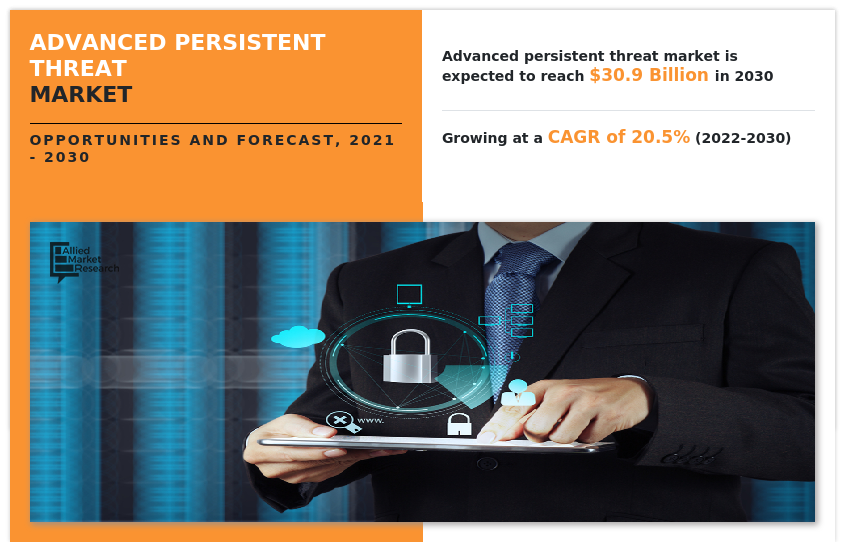
It is crucial for vendors to offer solutions that logically identify and relate information about a potential attack across many sources and channels because of the most accessible systems via which attacks are feasible to include web access and email. Software, physical or virtual appliances, private or public clouds, and hybrid models are just a few of the different ways that these solutions can be used. In order to identify and defend against advanced persistent threats, network administrators, security companies, and individual users use a variety of security techniques, such as traffic monitoring, bot-bot protection, and access control.
APT-like cyberattacks are on the rise globally, which is primarily driving the significant expansion of the Advanced Persistent Threat (APT) security market. For instance, the Federal Bureau of Investigation (FBI) and the Cybersecurity and Infrastructure Security Agency (CISA) jointly alerted the public to APT threats in October 2020. As per their information the Sandworm APT, a group renowned for TeleBots used in high-profile hacks, was accused of working with six Russian citizens, according to accusations announced by the Department of Justice (DOJ). Therefore, most businesses, including those in retail, healthcare, and IT, are using integrated security services that may help to harden cloud environments against such APT-style attacks, which may eventually increase the demand for APT protection platforms, during the forecast period.
During the forecast time, it is anticipated that the higher cost of Advanced Persistent Threat (APT) protection platforms will hinder the expansion of the global market. Additionally, the global market for advanced persistent threat defense may suffer from a lack of awareness of APTs and their complexity.
Due to the rising use of cyber-security platforms in the healthcare industry, technical advancements in medicine and biological research have substantially increased in recent years. The platform is essential in identifying and correcting any risks or weaknesses related to Protected Health Information (PHI). Additionally, a number of benefits are provided by this highly developed platform, including the authentication of data storage, approval of security measures, secure data transmission, and risk assessment. As a result, some healthcare organizations have chosen to deploy integrated security solutions in recent years.
For instance, in order to launch the "HITRUST Cyber Threat XChange (CTX) Deceptive program," which aids in the deployment of honeypots throughout the healthcare ecosystem, in October 2017, the leading player in information technology and services, HITRUST Alliance, entered into a partnership with Trend Micro Incorporated, an American-Japanese multinational cyber security software company. The worldwide APT protection market may benefit in the future from such technological advancements.
The key players profiled in this report include Cisco Systems, Inc., AO Kaspersky Lab., ESET spol. S r.o., Sophos Ltd., Forcepoint, VMware, Inc, Microsoft, Palo Alto Networks, McAfee, LLC, and F-Secure.
The global advanced persistent threat market share is segmented based on deployment mode, services, solutions, and region. By deployment mode, it is classified into cloud and on-premise. By services, it is classified into Security Information and Event Management (SIEM), endpoint protection, Intrusion Detection System/ Intrusion Prevention System (IDS/ IPS), sandboxing, Next-Generation Firewall (NGFW), forensic analysis, and others. By region, the market is analyzed across North America, Europe, Asia-Pacific, and LAMEA.
By deployment type, the on-premise sub-segment dominated the market in 2019, whereas the cloud sub-segment is projected to be the fastest growing during the forecast period. The rising demand for cloud-based APT protection is mostly due to its affordability, critical role in disaster recovery, rising concern about integrated safety standards among businesses, and accessibility of cloud security services for both small and large firms. Increasing dependability and simple data access are encouraging the use of cloud services in many businesses, which is driving the segment revenue growth globally. The market for ATP protection has changed over the past years, moving from typical, simple malware outbreaks to complex and zero-day threats.
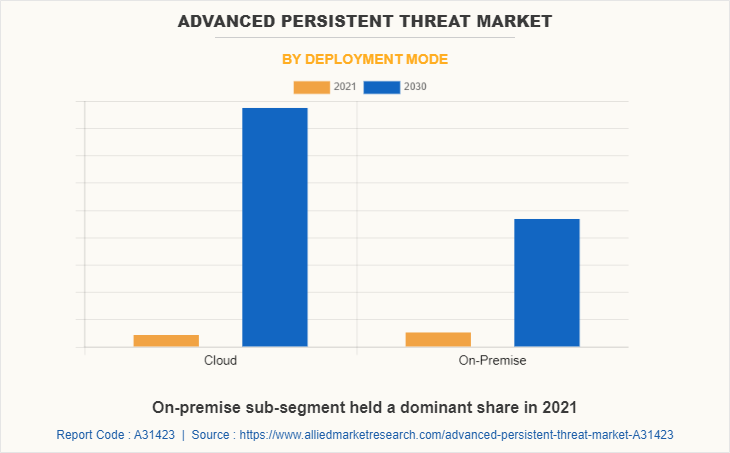
By services, the managed services sub-segment emerged as the global leader in 2019, and the professional services sub-segment is anticipated to be the fastest growing sub-segment during the forecast period. Businesses have been forced to pay attention to system vulnerability leading to a sudden surge in malicious activity across a variety of sectors, including IT & telecommunications, healthcare, and retail.
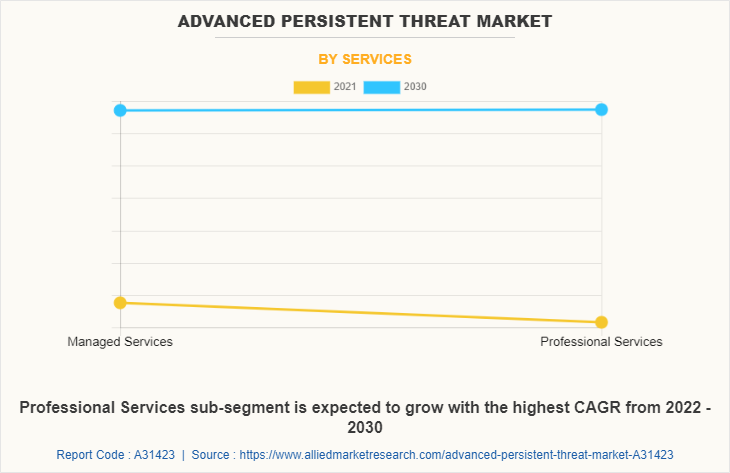
One of the key factors fueling the sub-segment growth during the projection period is significantly increasing cyber vulnerabilities in both developed and developing countries. In addition, the widespread use of 5G infrastructure and substantial increase in technological assistance are some of the elements anticipated to fuel the demand for integrated security, which may ultimately flourish the sub-segment market growth.
By solutions, the security information & event management sub-segment dominated the global advanced persistent threat protection market share in 2019, whereas the next-generation firewall sub-segment is anticipated to have the fastest growth during the forecast period. During the forecast period, it is projected to have a significant increase in demand for continuous monitoring and incident response, log management and storage, and compliance. These are just a few of the major drivers projected to drive this growth. Smart devices, such as smartphones, TVs, tablets, and laptops, have substantially increased their connectivity in recent years. The widespread adoption of the IoT has raised awareness of and need for network infrastructure protection, which is expected to promote market expansion.
Additionally, prominent firms providing cyber security services are forming partnerships and releasing cutting-edge products due to the high functionality of NGFW Solutions. As an example, Citrix and Check Point Software Technologies, one of the prominent providers in integrated security services, officially announced their collaboration to provide Next-Generation Firewall, in May 2020. In the coming years, the sub-segment is anticipated to benefit greatly from these important advances.
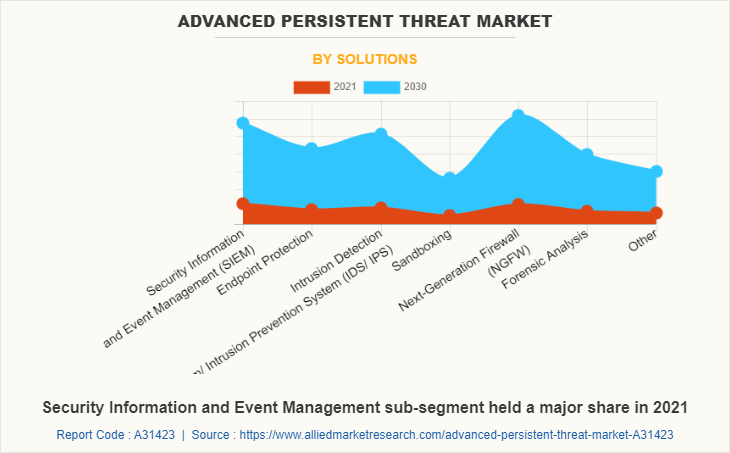
By region, North America dominated the global market in 2019, and Asia-Pacific is projected to be the fastest-growing sub-segment during the forecast period. The sustainable and well-established countries in North America, especially the U.S. and Canada, significantly spend on R&D operations. For instance, the U.S. Department of Energy (DOE) announced in May 2019, that it would invest $8 million in innovative security measures to increase the resilience and dependability of the nation's energy infrastructure. These investments might have a favorable effect on the market. Furthermore, the market for Advanced Persistent Threat (APT) protection in the North American area is anticipated to benefit from the prominence of APT protection platform providers such as Broadcom, Fortinet, McAfee, and others.
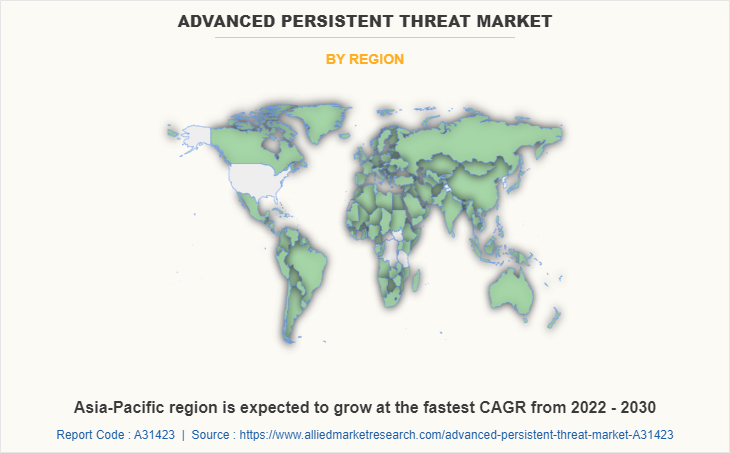
The ongoing technological advancements in nations such as India, China, Singapore, and Australia are responsible for the market expansion of the Advanced Persistent Threat (APT) protection sector in the APAC regions. In the next years, demand for APT security platforms is also anticipated to rise due to the region-wide sharp increase in cyberattacks.
Key Benefits For Stakeholders
- The report provides an exclusive and comprehensive analysis of the global advanced persistent threat market trends along with the advanced persistent threat market forecast
- The report elucidates the advanced persistent threat protection market opportunity along with key drivers, and restraints of the market. It is a compilation of detailed information, inputs from industry participants and industry experts across the value chain, and quantitative and qualitative assessment by industry analysts
- Porter’s five forces analysis helps analyze the potential of the buyers & suppliers and the competitive scenario of the market for strategy building
- The report entailing the advanced persistent threat protection market analysis maps the qualitative sway of various industry factors on market segments as well as geographies
- The data in this report aims at market dynamics, trends, and developments affecting the advanced persistent threat market growth
- The global report provides the advanced persistent threat market size for 2021 and forecast from 2022 - 2030.
Impact of COVID-19
- The APTs are sophisticated cyberattacks carried out by well-resourced and organized cyber criminals. During the COVID-19 pandemic, the market for advanced persistent threat (APT) defense has experienced considerable growth.
- Globally, the pandemic has presented enormous business challenges. In the midst of the COVID-19 chaos, a wide range of global market sectors, including IT & communications, healthcare, and retail, have become vulnerable to APT attacks.
- Therefore, the bulk of the major players are creating innovative goods to aid businesses in the face of the epidemic
- For instance, American multinational cybersecurity company Palo Alto Networks debuted the first Next-Generation Firewall based on machine learning in June 2020 (ML-Powered NGFW). The platform aids with cyber threat prevention, proactive IoT device security, and security policy recommendations.
- The worldwide APT protection market is being positively impacted by these firms' situational and creative product launches during the pandemic
Advanced Persistent Threat Market Report Highlights
| Aspects | Details |
| By Deployment Mode |
|
| By Services |
|
| By Solutions |
|
| By Region |
|
| Key Market Players | VMware, Inc., AO Kaspersky Lab., Sophos Ltd., Palo Alto Networks, Cisco Systems, Inc., Raytheon Technologies Corporation, McAfee, LLC., Microsoft, FireEye, F-Secure |
Analyst Review
The proliferation of cloud-based APT protection solutions and services, as well as the rising incidence of security breaches and sophisticated cyber-attacks such as ransomware, malware, and zero-day exploits, are the key factors projected to drive revenue growth of the global advanced persistent threat protection market during the forecast period. In addition, another important factor is the strict government regulations governing the adoption of APT protection policies, which is expected to fuel revenue growth of the market in the forecast timeframe.
However, higher cost of Advanced Persistent Threat (APT) protection platforms are predicted to hinder the expansion of the global market and hamper the market revenue growth during the forecast period. The need for sophisticated cyber-security is being driven by the rising number of cyber-attacks on the healthcare industry and others, which is also anticipated to open up new market opportunities.
Among the analyzed regions, North America is expected to account for the highest revenue in the market by the end of 2030. Government investments in innovative security approaches are the key factors responsible for dominating position of North America in the global advanced persistent threat protection market
The rising incidence of security breaches and sophisticated cyberattacks such as ransomware, malware, and zero-day exploits are the major market driving factors in the advanced persistent threat protection market. In addition, another important factor is the strict government regulations governing the adoption of APT protection policies, which is expected to fuel revenue growth of the market in the forecast timeframe.
The major growth strategies adopted by advanced persistent threat protection market players are investment and merger & acquisitions.
North America will provide more business opportunities for the global advanced persistent threat protection market in future.
Cisco Systems, Inc., AO Kaspersky Lab., ESET spol. S r.o., Sophos Ltd., Forcepoint, VMware, Inc, Microsoft, Palo Alto Networks, McAfee, LLC, and F-Secure are the major players in the advanced persistent threat protection market.
The on-premise sub-segment of the deployment mode acquired the maximum share of the global advanced persistent threat protection market in 2021.
IT & telecommunication companies and healthcare companies are the major customers in the global advanced persistent threat protection market.
The report provides an extensive qualitative and quantitative analysis of the current trends and future estimations of the global advanced persistent threat protection market from 2021 to 2030 to determine the prevailing opportunities.
The use of APT protection platforms for cybersecurity purpose is estimated to drive the adoption of advanced persistent threat protection.
Addressing the complexity of advanced threats and to protect the systems from malwares is anticipated to boost the advanced persistent threat protection market in the upcoming years.
Loading Table Of Content...



